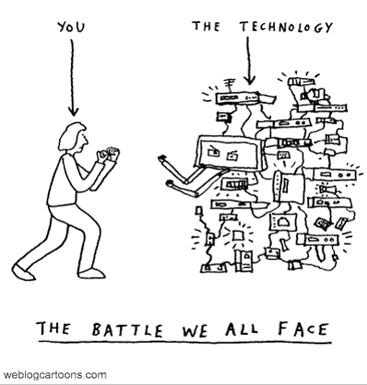
In Part One of The Other Side of Lurking, I wrote about the #HEdigID #OEP discussion (13/07/18) on Twitter. Every day this week something new has been added to the debate. It’s good to talk. Lurking risks being side-lined by the rhetoric of innovation and transformation. Let’s face it – digital shyness or resistance are usually less attention grabbing headlines.
Conclusions validate lurking as learning. It’s a valid strategy. So lurking’s not a problem, right?
…but if it’s your virtual environment and you’re dealing with silence, it can’t be ignored. Lurking flies in the face of everything we’re told 21st century education should be, namely active. We’re well versed in communities of practice and inquiry, zones of proximal development, social, cognitive and teaching presences, and so on – and they all require interaction.
Networks need people, don’t they?
We’re schooled to see communication and collaboration as the heart of active learning yet the data says otherwise. Whether we measure with Nielsen’s 90% or Pareto’s 80% non-participation rates – consumption without contribution is rife and suggests most of us are comfortable with digital isolation.
Are we creating a problem which doesn’t exist?

The scenario is familiar. I set up an online discussion, but no one used it, so I didn’t do it again.
Lurking can’t be ignored. Digital silence speaks but what is it saying?
Are the students ok or have they disappeared?
Are they managing their learning or are they struggling?
We wouldn’t run a seminar in silence.

I need to know lurking better.
My research is about digital shifts. How staff who teach and support learning conceptualise their practice in a digital age. What influences individual attitudes and behaviours. Data suggests the permanence of digital publication is frequently feared. Once words are in the public domain, they’re gone. No longer under control, let loose in an open arena, exposed to the responses of others and risking – many people believe – potential ridicule.
Damn Twitter’s lack of an Edit function. But its more than seeing carefully crafted ideas spoiled by typos. What if the ideas themselves are flawed in some way. What if you’ve used an incorrect reference, or inappropriate word or phrase. Worse, what if you’ve misunderstood the question or the reading, Suppose, just suppose, your thoughts are deemed incorrect and you’ve exposed your lack of knowledge about key concepts to the world.

From data collected over the years:
…what if I look foolish.
…what if I’m wrong.
…what if people think I’m stupid
The fear is once your words are out there you can’t get them back.
Sun, Rau, and Ma, (2014) categorise lurkish behaviours and under ‘personal dispositions’ they cite self-efficacy. This is the inner turmoil which influences attitudes and behaviours. Jerome Bruner described it as ‘people’s beliefs about their capabilities to produce designated levels of performance that exercise influence over events that affect their lives” (1994: 2)
Self-efficacy is our individual motivation driver. High self-efficacy fires you into action, underpinned by the ability to push yourself forward, believing you can achieve whereas low self-efficacy results in fear. It will come as no surprise, those with low self-efficacy have more self-doubt, spending inordinate amounts of time imagining 101 obstacles and 1001 possibilities of error.
They feel the fear and don’t do it.

A quick google search brings up connections between self-efficacy and technology. Where there’s tech there’s emotion. Liz Bennett at the University of Huddersfield has written about the emotional work involved when adopting digital practices. Technophobia might not be a top ten phobia but fear of public embarrassment before students is a common deterrent.

I’ve heard of academics not using PowerPoint in case the computer won’t switch on, and how many times have you seen a presenter unable to open their presentation because the file’s on their desktop, 100 miles away, or they can’t find it on their data stick.
It happens. Don’t laugh. Fear is real.
Lurking may be a valid learning strategy for some, but for others it’s looking like digital shyness.
In popular psychology there’s a condition called Imposter Syndrome (IS). This is about successful people feeling they’re frauds, believing it’s luck rather than skill or ability that’s got them where they are, and it’s only a matter of time before someone finds out. People with IS live in continual dread of making mistakes which they fear will expose them.

Imposter Syndrome sounds like self-efficacy by another name. First identified in 1978 (Clance and Imes) there’s an Impostor Phenomenon Scale (test yourself here) and while not an officially recognised disorder (IS is absent from any psychiatric diagnostic manuals) a whole IS business has emerged based on self-help and therapeutic interventions. Imposter Syndrome appears to provide a popular conceptual understanding of the underlying psychology. The phrase is in common use and I wondered if Digital Imposter Syndrome (DIS) could exist.
I googled but nothing came up. Not even a googlewhack. DIS returned zero.

Woo hoo! Was this a conceptual gap? Should I push the digital imposter syndrome idea a bit further or return to Bruner?
I went back to Jerome. In the Narrative Construction of Reality (1991) Bruner writes about the situated nature of knowledge, via cultural tool kits and distributed networks. Long ago, in a different university, I wrote about digital literacies being best understood as socially situated practices. They were personal, as individual as fingerprints, and determined how we operated online, but we all have differing amounts of digital capital, depending on socio/cultural/material locations. Maybe part of the solution to encouraging online engagement is to refocus on the development of literacies of the digital kind.

While competencies type training focusing on which button to click may have value, any change it effects can only ever be surface. We know learning requires deeper approaches so let’s start with building and supporting digital confidence in safe environments. Experiential digital practice can be transformative for both staff and students.
Where does this leave us with us lurking?
It’s a problem. We need to reduce the 90% and 80% consumption models.
Or do we?
If lurking is simply a reflection of ourselves, should we leave lurkers alone to do what they do best.
Assimilation in their own preferred way; to listen, watch, consume, absorb…. to learn.
Are effective online environments not about building and sustaining interaction after all? Should we rethink pedagogy and practice to support less active forms of learning? Or would that be a huge mistake?
This might need a Part Three, What do we do about lurking?
References
Bandura, A. (1994). Self-efficacy. In V. S. Ramachaudran (Ed.), Encyclopedia of human behavior (Vol. 4, pp. 71-81). New York: Academic Press. (Reprinted in H. Friedman [Ed.], Encyclopedia of mental health. San Diego: Academic Press, 1998) https://www.uky.edu/~eushe2/Bandura/Bandura1994EHB.pdf .
Bennett, L. (2014) Putting in more: emotional work in adopting online tools in teaching and learning practices. Teaching in Higher Education 19 (8), 919-930
Clance, P. and Imes, S. A. (1978) The Impostor Phenomenon in High Achieving Women: Dynamics and Therapeutic Intervention” Psychotherapy Theory, Research and Practice.
Sun, N., Rau, P. P. L., & Ma, L. (2014). Understanding lurkers in online communities: A literature review. Computers in Human Behavior, 38, 110-117.




























 Remember: the absence of face-to-face clues makes it easy to misinterpret messages. These quotes remind us online communication can be challenging. Prepare for silence! Reluctance to engage and mixed messages can affect retention.
Remember: the absence of face-to-face clues makes it easy to misinterpret messages. These quotes remind us online communication can be challenging. Prepare for silence! Reluctance to engage and mixed messages can affect retention. Remember: e-teachers are tutors, moderators, facilitators, instructors but called rarely e-lecturers. Teaching online requires digital communication skills while e-teachers have to shift identities from ‘Sage on the Stage’ to the less visible and more silent ‘Guide on the Side’, a loss of visible status which can take some adjusting to.
Remember: e-teachers are tutors, moderators, facilitators, instructors but called rarely e-lecturers. Teaching online requires digital communication skills while e-teachers have to shift identities from ‘Sage on the Stage’ to the less visible and more silent ‘Guide on the Side’, a loss of visible status which can take some adjusting to.


